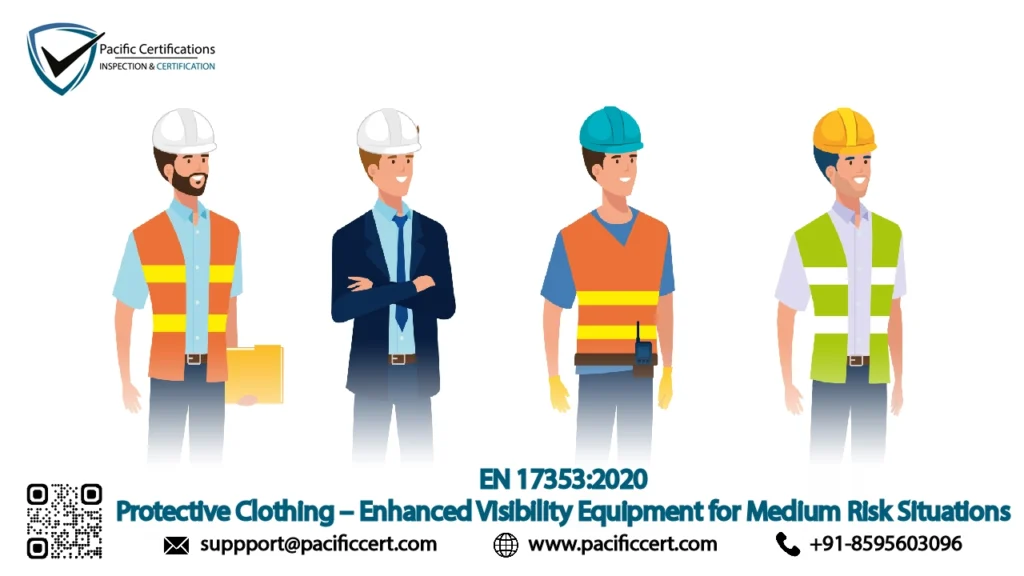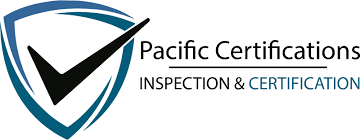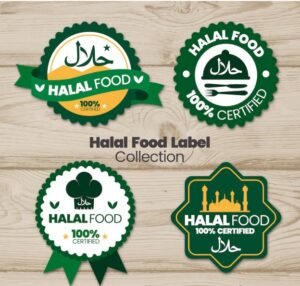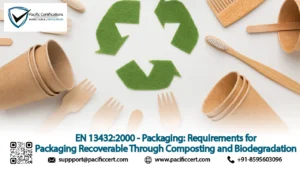What is EN 17353:2020?

EN 17353:2020 is a European standard that applies to protective clothing designed to offer enhanced visibility in medium-risk situations. This includes environments where visibility is crucial but conditions do not warrant the high visibility requirements of EN ISO 20471. The standard ensures that workers in low-light, off-road, or non-public road environments are still visible and safer while performing their tasks.
It covers garments that use fluorescent and retroreflective materials to increase detection by others. EN 17353 helps manufacturers, employers, and certifiers evaluate whether clothing offers appropriate visual signal levels for specific medium-risk settings.

For audit and certification assistance, contact us at support@pacificcert.com
Purpose
The purpose of EN 17353:2020 is to define visibility requirements for garments used in conditions where the likelihood of being hit by moving equipment exists but where full high-visibility gear may not be necessary. It supports manufacturers and safety officers in selecting or designing clothing that improves wearer visibility without overburdening the user or increasing material intensity beyond what the setting calls for.
Scope and Applicability
EN 17353:2020 applies to non-professional and professional use clothing intended to increase the visual conspicuity of the wearer in medium-risk scenarios. These include off-road work sites, warehouses, forestry operations, parks, and private industrial premises. It does not apply to clothing for emergency responders or public road workers covered by EN ISO 20471.
The standard applies to different garment types such as vests, shirts, trousers, and coveralls, including both day-use and night-use configurations. It is also relevant for manufacturers producing safety wear, employers in warehousing, logistics, light construction, and outdoor maintenance services.
Key Definitions
Conspicuity: The ability of an object to attract attention and be recognized by an observer under given conditions.
Fluorescent Material: Material that converts invisible ultraviolet light into visible light, improving daytime visibility.
Retroreflective Material: Material that reflects light back toward its source, improving visibility at night.
Combined-Performance Material: Material with both fluorescent and retroreflective properties.
Medium Risk: Environments where risk of collision exists but at a lower level than traffic-exposed areas.
Claue Wise Structure of EN 17353:2020
| Clause | Title | Description |
| 1 | Scope | Defines the applicability of the standard to garments for medium-risk visibility situations not covered by EN ISO 20471. |
| 2 | Normative References | Lists the essential standards (such as ISO 20471 and ISO 13688) required for interpreting and applying EN 17353. |
| 3 | Terms and Definitions | Explains key terms like conspicuity, fluorescent material, retroreflective material, and combined-performance material. |
| 4 | Performance Requirements | Details classification into Type A, B, or AB garments and sets out minimum visibility surface areas for each type. |
| 5 | Design Requirements | Specifies how materials must be placed on the garment to ensure visibility from all angles and that designs maintain surface area visibility. |
| 6 | Test Methods | Outlines test procedures to assess reflectivity, color fastness, durability, and visibility under washing or environmental exposure. |
| 7 | Marking and Labelling | Defines labeling rules, including the type classification (A, B, AB), pictograms, and care instructions. |
| 8 | Information Supplied by the Manufacturer | Lists the information that must accompany garments such as usage conditions, limitations, and maintenance guidelines. |
What are the EN 17353:2020 requirements?
To meet EN 17353, clothing must follow specific material placement and visibility requirements based on intended use conditions. The standard divides garments into three types depending on use during the day, night, or both. Below are the key requirements:

- Clothing must be classified as Type A (day), Type B (night), or Type AB (day and night)
- Type A garments must use fluorescent material to boost daytime visibility
- Type B garments must use retroreflective material for nighttime detection
- Type AB garments must use both material types for varied light conditions
- Each type must meet minimum surface area requirements defined in the standard
- Placement of materials must allow visibility from all angles of the wearer
- Materials must remain effective after repeated washing or exposure
- Stitching and design should not reduce the visible area below the allowed limit
- Garments must display the correct type classification with a pictogram
- Testing must follow ISO 20471 and other referenced visibility performance methods
What are the EN 17353:2020 benefits?
EN 17353:2020 allows employers and manufacturers to address specific safety concerns in moderately hazardous visibility settings. Below are the key benefits:

- Increases worker visibility in off-road and industrial environments where low light or moving machinery is present
- Supports site-specific risk planning by offering graded visibility levels without over-specification
- Allows more comfort and flexibility compared to high-visibility clothing that may be heavier or bulkier
- Reduces incident likelihood in warehouses, factory yards, and other semi-private workspaces
- Helps employers meet safety policies when EN ISO 20471 does not apply but visual identification is still needed
- Encourages correct garment use through clearer labeling and classification
- Supports procurement decisions for tailored safety equipment budgets
Visibility gear demand is increasing in logistics hubs, warehousing zones, and industrial parks where vehicle-human interaction risk remains but public traffic exposure is low. Since 2023, large companies in utilities and light manufacturing sectors have added EN 17353-rated clothing to their safety programs to address equipment-related incidents in internal zones. Visibility compliance is now part of internal audits for several European and Asian firms operating in warehousing and fleet maintenance. New product designs using lightweight fabrics and flexible reflective trims have also been introduced to meet the growing interest in visibility without high-visibility bulk.
EN 17353:2020 Certification Process
- Identify the visibility risk level and intended use environment for each garment
- Classify the garment as Type A (day use), Type B (night use), or Type AB (combined use)
- Review the garment’s material layout, surface area coverage, and visibility zones
- Conduct laboratory testing based on ISO 20471 or equivalent standards to assess reflectivity and durability
- Submit technical documentation and test reports to the certification body for evaluation
- Stage 1 audit – Review of submitted documents, garment labeling, and classification accuracy
- Stage 2 audit – Factory inspection, production checks, and verification of on-garment conformity
- Receive certification along with type marking and instructions for correct garment usage
EN 17353:2020 Certification Timeline
The certification timeline ranges from six to eight weeks. If the garments have been pre-tested or partially conform to ISO 20471 standards, the process may be shorter. New garments with unique materials or designs may require extra testing, extending the timeline to ten weeks.
What is the EN 17353:2020 cost?
Costs depend on garment quantity, number of types (A, B, AB), and whether material testing is required. Items using certified fabrics may lower the cost. Bundled audits with EN ISO 20471 or EN ISO 13688 can reduce total expenses for manufacturers offering multiple safety garment types. To know more about the costing, contact us at support@pacificcert.com.
How can Pacific Certifications help?
Pacific Certifications offers third-party audits and verification services tailored to EN 17353. We support manufacturers, distributors, and safety gear suppliers in certifying visibility garments for medium-risk environments. Our process ensures that each item is reviewed thoroughly for material use, labeling, durability, and placement compliance.
- We assess material combinations to verify compliance with Type A, B, or AB classifications
- We review technical files and markings to confirm garment labeling accuracy
- We verify surface area calculations and retroreflectivity values
- We test post-wash and environmental durability for real-world wear conditions
- We support batch testing protocols for multiple garment types
- We offer bundled audits for EN ISO 20471, EN ISO 13688, and other PPE-related standards
Training and Courses
Lead Auditor Training: Focuses on how to audit visibility garments against EN 17353 in factory and supplier settings.
Lead Implementer Training: Trains safety officers and design teams to integrate EN 17353 into workwear specifications and procurement.
Internal Auditor Training: Helps quality and compliance teams monitor ongoing conformity during production.
Pacific Certifications provides accredited training programs. If your organization is looking for EN 17353 training our team is equipped to help you. Contact us at support@pacificcert.com
FAQs
- Is EN 17353 the same as EN ISO 20471?
No, EN 17353 is for medium-risk visibility needs. EN ISO 20471 applies to high-risk public road situations.
- Can leisurewear be certified under EN 17353?
Only if the clothing is intended to improve safety in a medium-risk setting. Fashion items do not qualify.
- Do I need fluorescent material for night use?
No, Type B garments use retroreflective material only for night-time use.
- Is EN 17353 accepted in non-European countries?
It is gaining acceptance in industrial procurement in Asia and parts of South America, especially where EN standards are referenced.
- Can children’s clothing be certified?
Yes, if intended for visibility in non-public settings like parks or private school areas, and if the garment meets material and placement requirements.
Ready to get EN 17353:2020 certified?
Contact Pacific Certifications to begin your certification journey today!
Suggested Certifications –
Read more: Pacific Blogs






